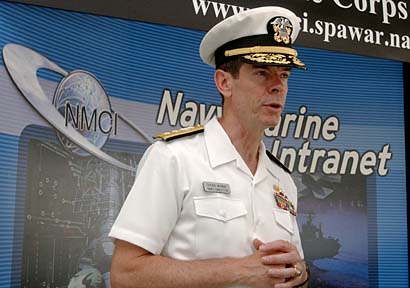


|
Ford Island’s The Navy's newest computer system on Ford Island has more than enough memory space to store all of the books and reference materials now held by the Library of Congress in Washington, D.C.
’Net gains
A new Navy computer system
packs power for the futureBy Gregg K. Kakesako
gkakesako@starbulletin.comThat means a memory capacity large enough to hold more than 120 million items that take up approximately 530 miles of bookshelves in the largest library in the world. At last count the Library of Congress's collections included more than 18 million books, 2.5 million recordings, 12 million photographs, 4.5 million maps and 54 million manuscripts.
Gerry Harvey, manager of the Navy-Marine Corps Intranet Network Operations Center at Ford Island, said his operation is capable of storing 240 terabytes of information in two memory banks called "silos." Information is stored on tapes that can hold 60 gigabytes of information. Each silo can hold 6,000 tapes.
"To try to put this into perspective," Harvey said, "many personal computers being sold today come with a single 30- gigabyte hard drive."

|
That means, Harvey said, that just one of Ford Island's new storage silos can store information equivalent to 8,000 30-gigabyte personal computer hard drives.It is one of three information storage facilities maintained by the Navy in Hawaii. The other two are at Camp Smith and Marine Corps Base Hawaii at Kaneohe Bay.
"All four storage silos," Harvey said, "have the capability to store one-half of all the reference materials now held by all the universities in the United States."
The center is located in what was once an airplane hangar built before World War II that survived the Japanese attack on Pearl Harbor in 1941. Since the 35,000-square-foot hangar is a historical landmark, Navy contractors were not allowed to alter the exterior of the building.
Last Tuesday, the center became part of the Pentagon's most extensive and expensive technology program, the Navy-Marine Corps Intranet. The state-of-the-art computer information system is the Navy's attempt to consolidate more than 200 different computer information systems under one technology.

|
The hope is that by next year all sailors and Marines ashore and at sea will be able to exchange data, video and voice communication instantaneously through their own private, secure intranet system.Satellite communications would eventually connect ships at sea with this secure system. With just a click of a mouse, sailors and Marines anywhere in the world could use the system to order parts, maintain their personnel records or to access classified data.
Eventually, Army and Air Force computer systems are supposed to be compatible with it.
Two other network operations centers have been constructed in Norfolk, Va., and San Diego.
The Ford Island facility is the first outside of the continental United States.
Since work began on Ford Island to convert the vacant hangar into a computer center, the Navy has spent more than $65 million in fabricating, constructing and installing the computer systems. More than 500 people were employed during the construction phase of the project, which began in December and ended in April. Another $35 million was spent to upgrade the computer facilities at Camp Smith and Kaneohe Bay.
Mike Finn, director of the Navy Establishment for the Navy-Marine Corps Intranet Information Strike Force, estimates that another $12 million to $15 million will be spent here annually to maintain the Ford Island operations, which eventually will employ 200 civilians and 75 sailors and Marines.
Rear Adm. Charles L. Munns, director of the new Navy-Marine Corps Intranet, said that as the Navy's computer information systems developed, "there were a thousand different networks. . . that grew up differently. There were problems of compatibility between these networks. There were problems of security, and we were spending a lot of time and effort keeping these networks together."
The Navy has estimated that the new system should translate into a savings of $2 billion over the life of the five-year, $6.9 billion contract.
Harvey said that the Ford Island center will be able to serve nearly 12,000 Navy and Marine Corps computer users in Hawaii by the end of this year.
"Eventually, it could service up to 40,000 computers stationed throughout the Pacific including Guam, Japan, Okinawa and Diego Garcia," he said.
But the installation and conversion to a new computer system has had its glitches.
Texas-based Electronic Data Systems Corp. was awarded the contract in October. Since then the Navy has spent $100 million to implement it, buying 160,000 workstations, which includes desktop computers, software and related support systems. The Navy had hoped to order 150,000 more by Sept. 30.
However, the U.S. House approved language in its version of the defense appropriations bill last month that said the Navy cannot expand its new communications network until more tests are done.
Munns said that should not be a problem.
"I see Congress looking at a few spots where we have deployed the system, and there is concern on how we are going to test the system," he said.
U.S. Rep. Neil Abercrombie said the action by the House merely represents concerns "to make sure the system does everything it's supposed to do."
U.S. Sen. Daniel Inouye said he will ensure that the Navy's computer system gets proper funding.
Abercrombie and Inouye, as well as other members of Hawaii's congressional delegation, were at Ford Island Tuesday to show their support for the new computer system.
More testing of the system will take place this summer, Munns told reporters. "We will make it work."